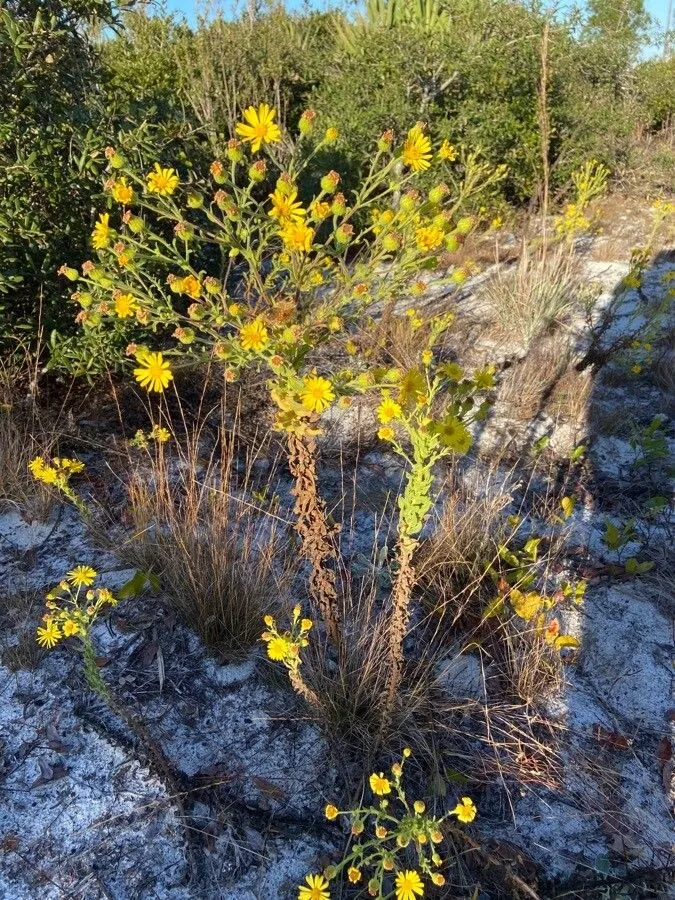
Author: (Lam.) Britton & Rusby
Bibliography: Trans. New York Acad. Sci. 7: 10 (1887)
Year: 1887
Status: accepted
Rank: species
Genus: Heterotheca
Vegetable: False
Observations: U.S.A. to Belize
The Camphor daisy, known scientifically as Heterotheca subaxillaris, is a notable member of the Asteraceae family. This flowering plant has a prominent presence from the United States all the way down to Belize, showcasing a wide geographical adaptability.
The Camphor daisy typically thrives in a variety of environments and is often recognized by its bright, cheerful yellow flowers that bloom abundantly, making it a colorful addition to the landscape. The plant is distinguished by its aromatic properties, which are especially noticeable when its leaves are crushed, releasing a scent reminiscent of camphor.
This species was first formally described in Transactions of the New York Academy of Sciences in 1887 by botanists Britton & Rusby, who cataloged the species under its current scientific nomenclature. The textual evidence from this publication plays a crucial role in understanding the early botanical exploration and classification of the Camphor daisy.
Apart from its visual appeal and distinctive fragrance, Heterotheca subaxillaris is also of interest due to its ecological utility. It attracts pollinators such as bees and butterflies, thereby contributing to the biodiversity of the habitats it occupies. As such, it holds value not just for botanists and horticulturists but also for ecologists dedicated to preserving natural pollinator populations.
In summary, Heterotheca subaxillaris, or Camphor daisy, is more than just a plant of aesthetic value. It serves an essential role in its ecosystem, bridging the gap between ornamental horticulture and ecological significance. This hardy and aromatic daisy continues to intrigue and delight those who encounter it across its extensive range from North America to Central America.
Heb: tiyonit ha’holot, טיונית החולות
Eng: camphor daisy, camphorweed, camphor weed
Swe: kamferört, kamferkrissla
En: Camphor daisy, Camphorweed, Telegraph plant, Camphorweed Golden-aster, Camphorweed Goldenaster, Camphor false golden-aster, Golden aster, Camphor weed
He: Tiyonit ha’holot, טיונית החולות
Sv: Kamferört, Kamferkrissla
Taken Sep 6, 2018 by Matthias Foellmer (cc-by-sa)
Taken Jan 26, 2022 by Trap Hers (cc-by-sa)
Taken Sep 12, 2015 by Sylvain Piry (cc-by-sa)
Taken Jan 26, 2022 by Trap Hers (cc-by-sa)
Taken Oct 6, 2020 by Matthias Foellmer (cc-by-sa)
Taken Jan 26, 2022 by Trap Hers (cc-by-sa)
Taken Dec 24, 2021 by Teresa Teresa (cc-by-sa)
Taken Sep 6, 2018 by Matthias Foellmer (cc-by-sa)
Taken Jan 7, 2021 by Tsvika Friedman (cc-by-sa)
Taken Feb 15, 2021 by ofirmgr (cc-by-sa)
Taken Feb 15, 2021 by ofirmgr (cc-by-sa)
Taken Sep 12, 2015 by Sylvain Piry (cc-by-sa)
Taken Sep 29, 2022 by Victoria Schaller (cc-by-sa)
Taken Sep 16, 2019 by William Elliott (cc-by-sa)
Taken Feb 15, 2021 by ofirmgr (cc-by-sa)
Taken Feb 15, 2021 by ofirmgr (cc-by-sa)
Taken Sep 20, 2022 by Julia Flowerpot (cc-by-sa)
Taken Sep 2, 2019 by YC (cc-by-sa)
Taken Dec 9, 2020 by karin or (cc-by-sa)
Taken Apr 6, 2021 by Trap Hers (cc-by-sa)
Taken Apr 3, 2021 by Trap Hers (cc-by-sa)
Taken Jan 26, 2022 by Trap Hers (cc-by-sa)
Taken Oct 11, 2020 by Matthias Foellmer (cc-by-sa)
Taken Oct 6, 2020 by Matthias Foellmer (cc-by-sa)
© copyright of the Board of Trustees of the Royal Botanic Gardens, Kew.
© copyright of the Board of Trustees of the Royal Botanic Gardens, Kew.
© copyright of the Board of Trustees of the Royal Botanic Gardens, Kew.
Growth habit: Forb/herb
Family: Myrtaceae Author: (F.Muell.) K.D.Hill & L.A.S.Johnson Bibliography: Telopea 6: 402 (1995) Year: 1995 Status:…
Family: Rubiaceae Author: Pierre ex A.Froehner Bibliography: Notizbl. Bot. Gart. Berlin-Dahlem 1: 237 (1897) Year:…
Family: Sapindaceae Author: Koidz. Bibliography: J. Coll. Sci. Imp. Univ. Tokyo 32(1): 38 (1911) Year:…
Family: Asteraceae Author: A.Gray Bibliography: Pacif. Railr. Rep.: 107 (1857) Year: 1857 Status: accepted Rank:…
Family: Fabaceae Author: Medik. Bibliography: Vorles. Churpfälz. Phys.-Ökon. Ges. 2: 398 (1787) Year: 1787 Status:…
Family: Aspleniaceae Author: (Cav.) Alston Bibliography: Bull. Misc. Inform. Kew 1932: 309 (1932) Year: 1932…